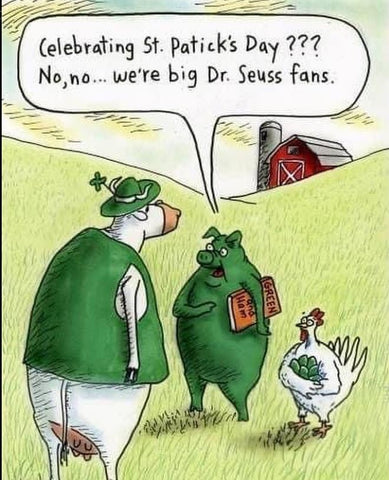St. Patrick's Day,2025

Top o' the morning to ya! 🍀
It’s St. Patrick’s Day, and for many, that means plenty of festive cheer!
Whether you're joining the celebrations or simply soaking in the season, it's a wonderful time to welcome the signs of spring, along with vibrant bursts of Shamrock Green and lucky Four-Leaf Clovers.
Four-Leaf Clovers symbolize faith, hope, luck, and love... all the good things that keep us springing forward!
Back in the day, my Mom would say, "Don't be mean; wear green!" 😂

Who exactly was St. Patrick? Did the legend about banishing snakes hold any truth? Furthermore, what prompted the emergence of numerous St. Patrick's Day traditions in America?

Although St. Patrick's Day is currently linked with wearing green, parades (if not canceled), and indulging in beer, its origins trace back over 1,500 years. The earliest documented observances date to the 17th century, occurring on March 17 to commemorate the death anniversary of St. Patrick in the 5th century. Explore further into the history of this holiday and its transformation into the contemporary celebration it has become.
1. The Real St. Patrick Was Born in Britain
The majority of information regarding St. Patrick's life has become entangled with folklore and myth. Historians typically accept that St. Patrick, Ireland's patron saint, was born in Britain, not Ireland, toward the latter part of the 4th century. At 16, he was abducted by Irish raiders and sold into slavery to a Celtic priest in what is now Northern Ireland. Enduring six years as a shepherd, he eventually managed to flee back to Britain. Later, he made his way back to Ireland as a Christian missionary.
2. St. Patrick Was Never Officially Canonized
Although revered as a patron saint, St. Patrick did not undergo formal canonization by the Church during his lifetime. This absence of canonization stemmed from the nonexistence of such a process when he passed away in A.D. 461. It wasn't until 993 that St. Ulrich of Augsburg became the inaugural saint to undergo formal canonization, and not until the 12th century that the Church established an organized canonization procedure supervised by the Pope. Despite lacking formal canonization, St. Patrick is widely regarded as holding saintly status by many.
3. No Snakes Existed in Ireland for St. Patrick to Expel
One of the enduring legends surrounding St. Patrick is the tale of him standing on an Irish hillside and driving away snakes from Ireland, causing them to flee into the sea. However, evidence indicates that snakes never inhabited the Emerald Isle in the first instance. The fossil record of Ireland shows no indication of snakes, and the presence of water surrounding the island since the last glacial period suggests that even before, during the ice age, the region would have been too frigid for reptiles to survive.
4. Leprechauns Likely Originated from Celtic Fairies
The iconic image of the red-haired, green-clad leprechaun has become closely tied to St. Patrick's Day. Originally known in Irish as "lobaircin," translating to "small-bodied fellow," leprechauns are believed to have their roots in Celtic folklore about fairies. These fairies, depicted as diminutive men and women, were believed to possess magical abilities capable of both benevolent and malevolent deeds. In Celtic tales, leprechauns were often portrayed as grumpy individuals tasked with repairing the shoes of other fairies.
5. The Shamrock Held Sacred Status
For centuries, the shamrock, a three-leaf clover, has been deeply intertwined with Irish culture. Known as the "seamroy" by the Celts, it was revered as a sacred plant symbolizing the onset of spring. Legend has it that St. Patrick utilized the shamrock as a visual aid to elucidate the concept of the Holy Trinity. By the 17th century, the shamrock had evolved into a potent symbol representing the burgeoning spirit of Irish nationalism.
6. Ireland's Sole Female Patron Saint, Brigid, Honoured with Her Own Holiday
Among the trio of patron saints in Ireland, St. Brigid (also known as Bridget) stands alongside St. Patrick and St. Columcille. Revered as the patron saint of various groups including Irish nuns, newborns, midwives, dairy maids, and cattle, Brigid is believed to have been born around A.D. 450 in Ireland. Born to a pagan king and an enslaved woman, she dedicated her life to serving the church. Notably, she erected a church in Kildare, which stood on the grounds of a former shrine dedicated to the Celtic goddess bearing her name.
7. The Inception of the First St. Patrick’s Day Parade Took Place in America
Although St. Patrick had been celebrated in Ireland since the 1600s, the tradition of hosting a St. Patrick’s Day parade originated in America and predates the establishment of the United States.
Historical records indicate that a St. Patrick’s Day parade occurred on March 17, 1601, in a Spanish settlement located in present-day St. Augustine, Florida. These festivities, along with a celebration the previous year, were orchestrated by Ricardo Artur, an Irish vicar residing in the Spanish colony. Over a century later, Irish soldiers serving in the English military, longing for their homeland, marched in parades in Boston in 1737 and New York City on March 17. The fervor for St. Patrick’s Day parades in cities like New York City and Boston continued to flourish thereafter. However, in 2020 and 2021, due to the COVID-19 pandemic, parades across the country, including those in New York City and Boston, were either canceled or postponed for the first time in decades. Fortunately, they resumed in 2022.
8. Irish Americans Faced Discrimination in America
Although Irish Americans now take pride in their cultural heritage, they were not always embraced by their fellow Americans. In 1845, a devastating potato blight led to widespread famine in Ireland, resulting in the deaths of approximately 1 million people. Another 2 million Irish citizens fled their homeland in what became the largest migration of the 19th century. The majourity of these refugees, constituting nearly a quarter of Ireland's population, sought refuge in the United States. However, upon their arrival, they were often subjected to discrimination, being perceived as carriers of disease, lacking in skills, and burdens on welfare systems.
9. Corned Beef and Cabbage: A Creation of America
The widely embraced St. Patrick’s Day dish, corned beef and cabbage, originated as an American innovation. While ham and cabbage were common fare in Ireland, corned beef emerged as a more economical alternative for impoverished immigrants. Irish Americans residing in the lower Manhattan slums during the late 19th and early 20th centuries often procured leftover corned beef from ships returning from China's tea trade. To prepare the dish, the Irish would boil the beef three times, the final time alongside cabbage, to diminish some of its briny flavour.
Happy St. Patrick's Day!
via history
